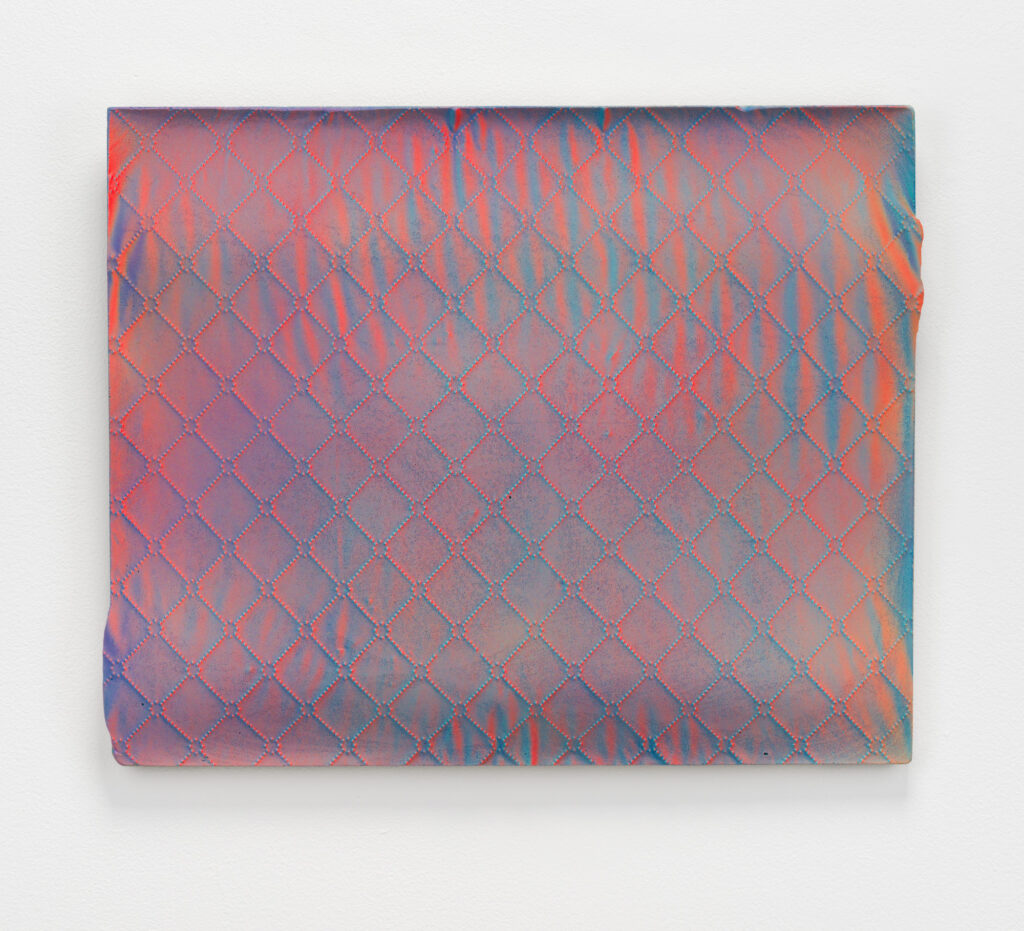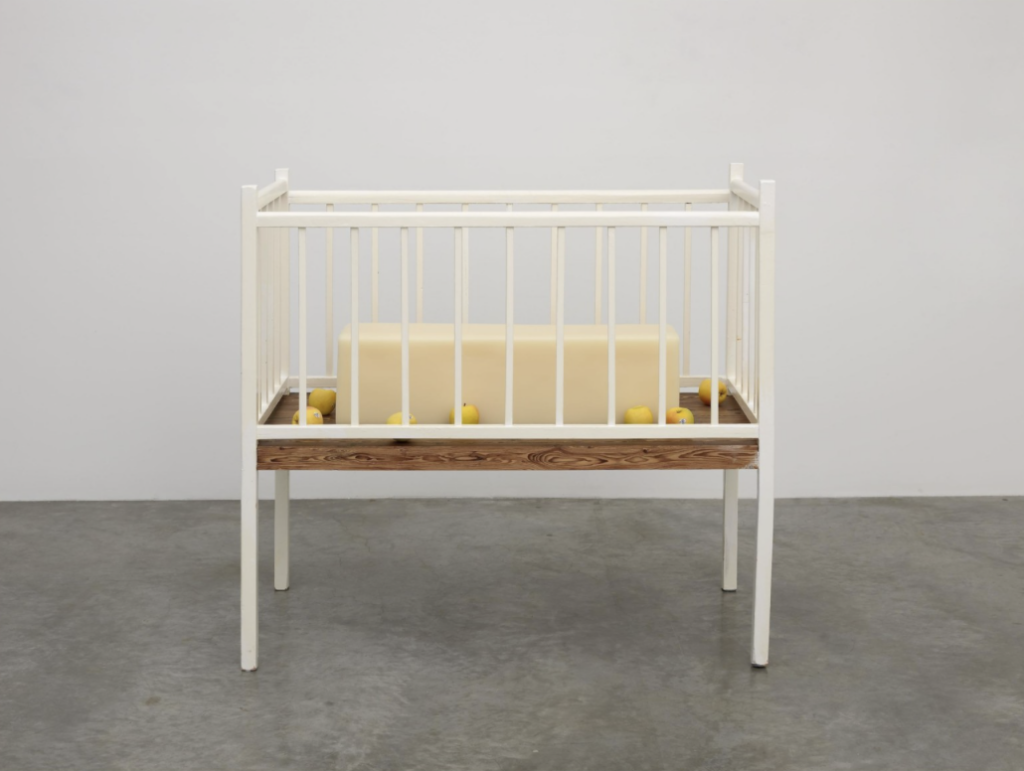On the eve of my daughter’s graduation, big launch, and leaving the family nest, I am in a proud moment of grief and growth. I am feeling the most unusual mix of emotions. As always, art is my salve.
Preemptively grieving last winter I was looking at a recent series of work by Colin Kippen. The work centers on disposable banal objects turned into brute, cement, permanent, and un-budging objects attached to the walls of a coffee shop in Portland. So the replaceable, plastic, don’t-need-those-any-more objects were reframed as art. I’ve worked with Colin before where I commissioned him to turn a design in my head into cement(1) because the best way to document your brain’s biggest questions, so you can return frequently to ponder in many directions, is to turn them into impenetrable objects. Yes, Sisyphean mind games help with cognitive flexibility.
On the walls in the café, were frozen solid baby blankets, and changing table pads memorialized in cement. In Colin’s artist statement, he describes the technical process of turning these daily, unmemorable objects into cement molds, pouring the cement, then carefully spray painting them to have a galactic effect that transforms the surface of the object depending on the light of day. All I could see on the wall as I stared at the changing table pad now turned to cement with a soft shimmer, moonscape color was the enigma of my children and how beautifully stuck I am as a mom. The mystery set in stone/cement is a thought that no matter my child’s age whether they are 12 or 45 they will always sit in my heart and mind’s eye as a child that I’ve just changed and dressed and hugged.

COLIN KIPPEN. Changing Patterns , 2023. Cement, wire mesh, picture wire, acrylic paint. 2023. 18″x15″x1.5″ Image courtesy Mario Gallucci and artist.
So while Colin, as an artist was looking to subvert throw-outable domestic objects into works of art, the results are small poems of intimacy, memory, and the messy hood of mothering/fathering/caregiving. Colin is among many artists, mostly women, who dive into the domestic to pull out highly saturated symbols into the Gallery space. Louise Bourgeois creates haunted rooms inspired by her childhood, Robert Gober has created distorted cribs, butter in cribs and steel rods piercing playpens, Mona Hautum creates conflict incarnate with her bottomless glass and steel cribs and violent pasta strainers, and Mary Kelly has dutifully documented her child’s infancy through an excruciatingly detailed diary. Why the domestic in the studio creates so much fear, confusion, sadness and claustrophobia is a curious aspect of inside-out-home art. Andy Warhol’s soap boxes somehow eluded the fearsome elements of the above artists mentioned. Could it be that the grocery store / consumer aspect of laundry detergent was exciting and safe for viewers? Any human who does laundry and has children knows it can be daunting, numbing and overwhelming, not to mention a constant reminder of how dirty we are. Perhaps it was the renewable cleaning aspect of soap that felt exciting for viewers, or the implied smell of the soap boxes that landed this work of art as a playful and domestic object in the art canon.

ROBERT GOBER. Untitled, 1993-2013. Wood, paint beeswax. 50″x 53″x 28″. Image courtesy the artist and Matthew Marks Gallery.
I bought the changing table piece by Colin that day. I stared at and felt deeply seen by the work. I have since been holding it in its packaging, in the wings not sure when and where to hang it as it brings so many emotions to the surface. Perhaps when my daughter leaves in August, I will hang it in the most intimate, sweet and calming area of my house so I can receive it in a way that comforts me.
Part of Colin’s beautiful series will be installed in downtown Portland at the new Soho House. If you can experience the work in person, please do try. They do not disappoint.
(1) The following is a work from my series “My Nose Made Me Do It” from 2019. Colin helped me with the cement pour (thank you Colin!).

CATHERINE HALEY EPSTEIN. Homage to Kandinsky and Arp: Concrétion Humaine, 2019. Cement and brass. 8.5″ x 13″ x 8.5″. Image courtesy the artist
In 1912 Wassily Kandinsky and Jean Arp were connected by their obsession of the notion of the spiritual made material. Kandinsky made two-dimensional work and wrote a book about the spiritual and art, and Arp created three-dimensional work in the hopes of conveying pure feeling through material. The two sparked a friendship and for years compared notes about the alchemy of material and the spirit. They called the finished artworks in this vein concrétion humaine. Concretion signifies the process of condensation, hardening, thickening and growing together. They used black and white to create tension in their compositions, where I have used concrete and perfume – the two polar opposite materials in the studio which create the strongest moods. The feeling is one I have had for years as I try to navigate the world of fragrance, the limitations and the endless possibilities inspire me daily.
Tagged: Cement Art, Colin Kippen, Contemporary Art, Domestic Art, Louise Bourgeois, Mary Kelly, Mona Hautum, Portland, Robert Gober
0 Comments
Would you like to share your thoughts?